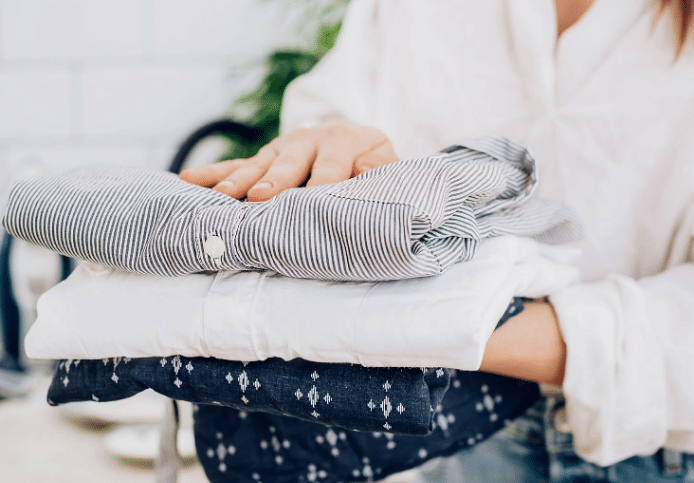Regardless of what season it is, we all need clothes. We want to make sure that they last as long as possible and don’t cost too much. That’s why this article is going to talk about the negatives of fabrics that you buy! There are many different types of fabric, but the fabrics on this list are some of the most common fabrics that have issues regarding durability and quality!
Cotton

Cotton is one of the most widely used materials in clothing because it’s incredibly comfortable and breathable. It can be produced at a relatively low cost and has a soft texture that feels good on your skin whether you wear it for casual or formal wear. Unfortunately, there are some negatives to wearing cotton clothes as well.
The soft texture of cotton isn’t as strong and durable as other fabrics, so it rips and tears much more quickly. If you wear your favorite pair of jeans every day for a couple of weeks, expect them to get holes and splits in the seams and fabric! Cotton is also not very water-resistant at all. The surface of each strand doesn’t have scales as wool does, so moisture quickly gets into the fabric and causes it to stretch out. If you get caught in the rain while wearing cotton clothes, don’t expect them to keep you very dry!
Leather

Leather is a very durable material that is great for protecting your body from the elements. Leather is standard for many different types of clothing and accessories. You’ll most often see leather items in outerwear like jackets and coats, but you can also find leather pieces such as shoes, belts, wallets, etc. However, there are some downsides to buying and wearing leather.
The main problem is that it’s not machine washable. If you spill something on your leather item or get dirt or sweat on it, you have to be very careful when cleaning it, so you don’t ruin the item. You also have to take special care when storing leather items because if they come in contact with other cloth items, they will stick together and potentially damage each other. Finally, while leather is exceptionally durable, no material is invincible! If you wear your leather shoes every day for an entire year, expect to get a new pair at least once because leather stretches and breaks down over time.
Wool

Wool is a viral material used in clothing because it’s super hot and comfortable to wear! It has tiny scales on the surface of each fiber that help hold the warmth inside your body even when it’s cold outside. This also makes wool very water resistant! Moisture just beads up and rolls right off of it.
Unfortunately, some negatives to wearing wool clothes might negate these benefits. Wool is a very delicate material that can be easily ripped if caught on something sharp or snagged in the wrong way. It also has tiny fibers on the surface of each strand called ‘prickle’ that can irritate if they come in contact with your skin. Wool also doesn’t breathe and other fabrics because moisture has a hard time getting out. It takes a lot of energy to evaporate, so you may feel uncomfortable wearing wool clothes during warm weather.
Polyester

Polyester is a solid material used in clothing, accessories, and many other places. It’s also highly affordable to produce, making it popular with companies who mass produce fashion items at low costs. However, there are downsides to polyester as well. One major downside is that polyester cannot absorb any moisture, so it’s not very breathable.
If you wear polyester clothes in warm weather, you can expect to feel extremely uncomfortable because your body won’t cool itself down. Another downside is that the fabric doesn’t have a natural feel, so many people don’t find it as comfortable as other fabrics. It’s very stiff and doesn’t drape as nicely on your body as cotton or wool does, so it can be uncomfortable to wear after a while.
Satin
Satin is often used to make formal dresses and gowns. It’s gleaming and reflective, so it tends to be the material of choice for expensive clothing, which makes it somewhat ironic that satin isn’t very durable! Satin has a skinny layer of fibers on its surface instead of scales like wool does, so it’s very fragile and tears easily.
The thin fibers absorb liquid very quickly, so the stains will be visible and problematic to get rid of. It also doesn’t breathe well because the surface of each strand is entirely smooth, which traps moisture inside. If you spill something on your satin clothing or get caught in the rain, don’t expect it to stay clean for long!
Nylon

Nylon is a common material used in clothing because it’s very lightweight, water-resistant, and inexpensive to make. It has many properties as wool, like moisture resistance and warmth-keeping capabilities, but nylon offers one key advantage: elasticity! You can stretch out your shirt or pants without worries that they will tear, unlike wool, which is very easy to rip.
Nylon has many of the same downsides as satin in that it’s not very forgiving when it gets dirty or stained. Spilling anything on your outfit will leave a mark and be hard to clean up. You can get around this problem by wearing dark colors, so stains aren’t as noticeable, but you also sacrifice some of the material’s other great qualities. Finally, nylon tends to fade with time and become worn-looking. You have to be very careful while washing or drying it to avoid tangling up in other items.
Rayon

Rayon is a synthetic material made from cellulose. It’s used to make many clothing and other fabric items because it has similar qualities to silk. If you’ve ever held rayon up to the light, you can see through it! That’s because rayon is very thin and pliable and drapes very well over the body. Like silk, it tends to be somewhat sheer and will show your skin underneath if you’re not careful with the color you choose. Rayon has similar disadvantages as satin and nylon when it comes to cleaning.
It’s difficult to get stains out of rayon because rayon is a very loose weave and the stains sink in between the fibers. When drying rayon, you also have to be careful because it clings to other fabrics easily, causing pilling if not separated carefully.
Conclusion
Hopefully, this article has given you ideas as to what to consider when looking for new clothes! There are many different fabrics used in clothing today, with both benefits and downsides. It’s essential to consider which properties you prioritize when choosing your clothes because some may not be as durable or comfortable as others. If you have questions about a specific item of clothing, it is best to consult a professional for their opinion.



